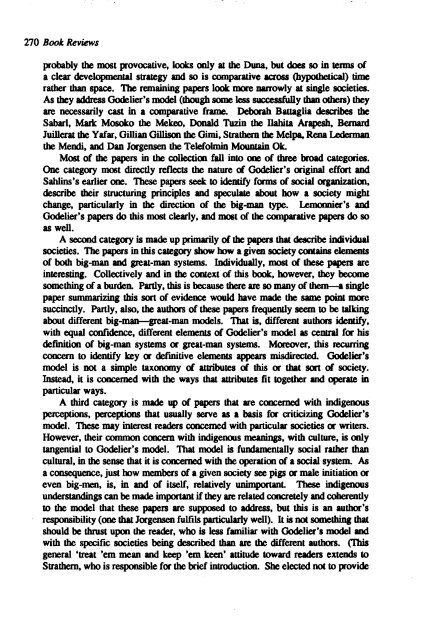1991 No. 1 CONTENTS - Institute of Social and Cultural ...
1991 No. 1 CONTENTS - Institute of Social and Cultural ...
1991 No. 1 CONTENTS - Institute of Social and Cultural ...
You also want an ePaper? Increase the reach of your titles
YUMPU automatically turns print PDFs into web optimized ePapers that Google loves.
270 Book Reviews<br />
probably tbe most provocative, looks only at tbe Duna, but does so in terms <strong>of</strong><br />
a clear developmental sttategy <strong>and</strong> so is comparative across (hypothetical) time<br />
rather than· space. The remaining papers look more narrowly at single societies.<br />
As tbey address Godelier's model (though some less successfully than others) tbey<br />
are necessarily cast in a comparative frame. Deborah Bauaglia describes tbe<br />
Sabarl, Mark Mosoko tbe Mekeo, DonaId Tuzin tbe Dabita Arapesh, Bemard<br />
Juillerat tbe Yafar, GiIlian GiIlison tbe Gimi, Stratbem tbe Melpa, Rena Lederman<br />
tbe Mendi, <strong>and</strong> Dan Jorgensen tbe Telefolmin Mountain Ok.<br />
Most <strong>of</strong> tbe papers in tbe collectioo fall into ODe <strong>of</strong> three broad categories.<br />
One category most directly reflects tbe nature <strong>of</strong> GodeIier's original effort <strong>and</strong><br />
Sablins's earlier ODe. These papers seek to identify forms <strong>of</strong> social organizatioo,<br />
describe tbeir structuring principles <strong>and</strong> speculate about how a society might<br />
change, particularly in tbe direction <strong>of</strong> tbe big-man type. Lemonnier's <strong>and</strong><br />
Godelier's papers do this most clearly, <strong>and</strong> most <strong>of</strong> tbe comparative papers do so<br />
as well.<br />
A second category is made up primarily <strong>of</strong> tbe papers that describe individual<br />
societies. The papers in this category show bow a given society contains elements<br />
<strong>of</strong> both big-man <strong>and</strong> great-man systems. Individually, most <strong>of</strong> tbese papers are<br />
interesting. Collectively <strong>and</strong> in tbe context <strong>of</strong> this book, however, tbey become<br />
something <strong>of</strong> a burden. Partly, this is because tbere are so many <strong>of</strong> tbem-a single<br />
paper summarizing this sort <strong>of</strong> evidence would have made tbe same point more<br />
succinctly. Partly, also, the authors <strong>of</strong> these papers frequently seem to be talking<br />
about different big-man-great-man models. That is, different authors identify,<br />
with equal confidence, different elements <strong>of</strong> Godelier's model as central for his<br />
definition <strong>of</strong> big-man systems or great-man systems. Moreover, this recurring<br />
concern to identify key or definitive elements appears misdirected.. Godelier's<br />
model is not a simple taxODOOly <strong>of</strong> atbibutes <strong>of</strong> this or that sort <strong>of</strong> society.<br />
Instead, it is concerned with tbe ways that attributes fit togetber <strong>and</strong> operate in<br />
particular ways.<br />
A third category is made up <strong>of</strong> papers that are concerned with indigenous<br />
perceptions, perceptions that usually serve as a basis for criticizing Godelier's<br />
model. These may interest readers concerned with particular societies or writers.<br />
However, their common coocem with indigenous meanings, with culture, is only<br />
tangential to Godelier's model. That model is fundamentally social rather than<br />
ctJltural, in tbe sense that it is concerned with tbe operation <strong>of</strong> a social system. As<br />
a consequence, just how members <strong>of</strong> a given society see pigs or male initiation or<br />
even big-men, is, in <strong>and</strong> <strong>of</strong> itself, relatively unimportant. These indigenous<br />
underst<strong>and</strong>ings can be made important if tbey are related coocretely <strong>and</strong> coherently<br />
to tbe model that these papers are supposed to address, but this is an author's<br />
responsibility (one that Jorgensen fulfils particularly Well). It is not something that<br />
should be thrust upon lbe reader, who is less familiar with Godelier's model <strong>and</strong><br />
with the specific societies being described than are lbe different authors. ('Ibis<br />
general 'treat 'em mean <strong>and</strong> keep 'em keen' attitude toward readers extends to<br />
Sttathem, who is responsible for the brief introduction. She elected not to provide
















